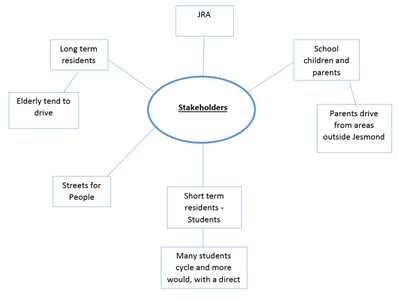Hello again,
Last week we met with our client Tony Waterston who is the chair of the JRA. During the seminar he gave us some new information crucial to the project as well as contact information for other people involved with S4P that could further our understanding of the program and situation. We also talked a lot about the different stakeholders and the problem with reaching out to them. One of the stakeholders we hadn’t considered was the younger demographic, a group that quite often gets left out. Waterston said that one of the goals for the project was that the area should be so safe that eight year olds should be able to move around there for themselves. We also discussed the fact that many students reside in the area and only stay for a few years at most, therefore they might not be as interested in the future of the neighbourhood compared to long term residents. Yet, their input is important nonetheless due to a continuous influx of students moving into the Jesmond area.
As shown by the mind map below there are a few different stakeholders that we have pointed out. When it comes to existing residents, it’s students that mostly use bikes to move around the area. We believe that a bigger percentage of students would cycle if there were direct cycle routes to the universities. We also have the long term residents, mostly elderly people who’ve lived in Jesmond for a long time, these tend to drive, adding to congestion in the area. The last group would be the school children and their parents, both who live in the area, as well as those who drive into Jesmond from other areas. It is the latter group that causes a lot of congestion around West Jesmond Primary school. Other stakeholders are of course the JRA and the Streets for People project.

Currently the JRA communicate information to the residents via mail, notice boards and library files but these options offer no way to gain meaningful feedback from the public. Residents in the area could if they want comment on the JRA website but this is not often used so the JRA still suffer from a lack of response from the community. The council on the other hand have better methods to obtain input from the people via means such as Let’s Talk, an online survey and discussion website for the residents of Newcastle, and committee meetings where local residents are welcome to take part in and give their opinion during a meeting with representatives from the council.

The main goal for our design is that all of these different groups should be able to use and understand it. Since it will be digital we are somewhat concerned that some of the older population will have a hard time comprehending the interface, while the younger generation probably won’t. Therefore it is important for us to have this in mind while designing. For now we have quite a clear view of what our client wants from us as a group and also some ideas as to how we would achieve that. However, after talking to our stakeholders we might discover other aspects that need to be included. In short our key questions for the sprint would be:
- How do we make an easy to understand interface for everyone while still being able to collect the information our client needs?
- We know what the client needs, but what is it that the stakeholders want?
During this week we will meet with some of the stakeholders to discuss these matters.
Hello team, thanks very much. This is a very good entry. You have clearly shown good reflective thinking, opening questions for further work that you might be able to refer to later. This level of self-reflection is very valuable and will help you deliver a strong design.
As for the content, you have done a very good job in identifying key stakeholders; and uncovering some additional ones that you had not considered before. In terms of your stakeholders, you could perhaps draw up some persona boards to cross reference what you know about specific stakeholders and their requirements; so this gives you an image of what kinds of people will interact with your digital concept (who you design for). As you keep exploring your stakeholder concerns keep going back to your stakeholder and process map and keep changing it / in reflection of your new insights.
Try to focus your efforts and your deliverables. You already have a really good process map and identified a high level process that you might be able to address, but try to refine it to some specific intervention. I suppose Tony and the S4P campaign are this ingredient to focus your project around.
Just note that the sprint questions could perhaps be expanded by one that reflects on what knowledge / insight you may gain through your creative design that you develop for Jesmond.